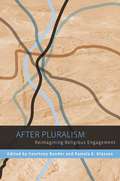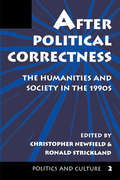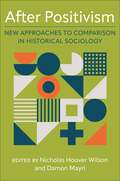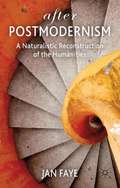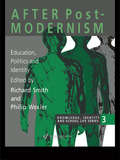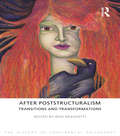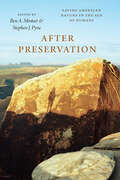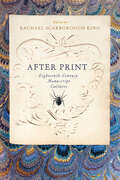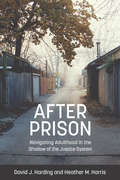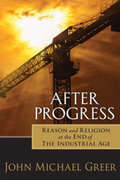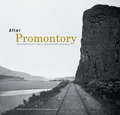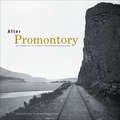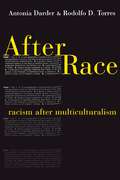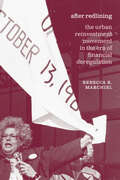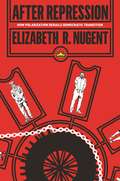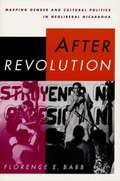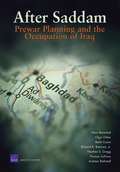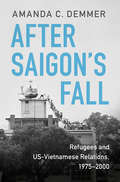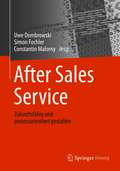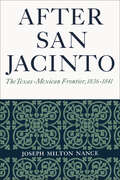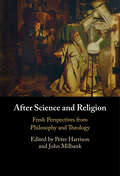- Table View
- List View
After Plato: Rhetoric, Ethics, and the Teaching of Writing
by John Duffy Lois AgnewAfter Plato redefines the relationships of rhetoric for scholars, teachers, and students of rhetoric and writing in the twenty-first century. Featuring essays by some of the most accomplished scholars in the field, the book explores the diversity of ethical perspectives animating contemporary writing studies—including feminist, postmodern, transnational, non-Western, and virtue ethics—and examines the place of ethics in writing classrooms, writing centers, writing across the curriculum programs, prison education classes, and other settings. When truth is subverted, reason is mocked, racism is promoted, and nationalism takes center stage, teachers and scholars of writing are challenged to articulate the place of rhetorical ethics in the writing classroom and throughout the field more broadly. After Plato demonstrates the integral place of ethics in writing studies and provides a roadmap for future conversations about ethical rhetoric that will play an essential role in the vitality of the field. Contributors: Fred Antczak, Patrick W. Berry, Vicki Tolar Burton, Rasha Diab, William Duffy, Norbert Elliot, Gesa E. Kirsch, Don J. Kraemer, Paula Mathieu, Robert J. Mislevy, Michael A. Pemberton, James E. Porter, Jacqueline Jones Royster, Xiaoye You, Bo Wang
After Pluralism: Reimagining Religious Engagement (Religion, Culture, and Public Life)
by Pamela E. Klassen Eds. Bender CourtneyThe contributors to this volume treat pluralism as a concept that is historically and ideologically produced or, put another way, as a doctrine that is embedded within a range of political, civic, and cultural institutions. Their critique considers how religious difference is framed as a problem that only pluralism can solve. Working comparatively across nations and disciplines, the essays in After Pluralism explore pluralism as a "term of art" that sets the norms of identity and the parameters of exchange, encounter, and conflict. <P><P>Contributors locate pluralism's ideals in diverse sites-Broadway plays, Polish Holocaust memorials, Egyptian dream interpretations, German jails, and legal theories-and demonstrate its shaping of political and social interaction in surprising and powerful ways. Throughout, they question assumptions underlying pluralism's discourse and its influence on the legal decisions that shape modern religious practice. Contributors do more than deconstruct this theory; they tackle what comes next. Having established the genealogy and effects of pluralism, they generate new questions for engaging the collective worlds and multiple registers in which religion operates.
After Political Correctness: The Humanities and Society in the 1990s
by Christopher NewfieldThis book resituates the political correctness debates in the humanities branch of the academy. Contending that conservatives have tainted entire academic disciplines, causing university humanists to go from irrelevant to dangerous overnight, the contributors see the PC debates as a struggle over the very purposes of higher education in the United States. Ronald Strickland and Christopher Newfield have assembled the best and the brightest from across the academic disciplines for disclosure on the future of higher education in light of PC.
After Positivism: New Approaches to Comparison in Historical Sociology
by Wilson, Nicholas Hoover; Mayrl, DamonWhat is the value of comparison for research in historical sociology? Today, social scientists regularly express doubt about the positivist premises that have long justified comparison’s use: that cases can be unproblematically compared as though they are independent of one another, that comparison can reliably yield valid causal inference, and that comparative methods can grapple with questions of meaning, sequence, and process that are central to historical explanation. Yet they remain reluctant to abandon comparison altogether, not least because comparisons are still manifestly useful in the research process.After Positivism presents a bold new set of warrants and methodologies for comparison that takes these criticisms fully into account. The contributors to this book marshal a wide array of postpositivist approaches to knowledge to reconstruct the analytic potential of comparison for a new generation of social scientists. In addition to providing fresh answers to classic questions about case selection and causal inference, authors ponder the role comparison plays in a world where social phenomena are demonstrably time-, space-, and concept-dependent; where causation is typically conjunctural; where social structures and groups emerge and die; and where important objects of inquiry can be understood only in terms of relationships, emergent properties, or contingent and irregular effects. Engaging and timely, this book will be of interest to all those who seek to improve our explanations of historical change in social-scientific research.
After Postmodernism
by Jan FayeThe philosophy of the humanistic sciences has been a blind-spot in analytic philosophy. This book argues that by adopting an appropriate pragmatic analysis of explanation and interpretation it is possible to show that scientific practice of humanistic sciences can be understood on similar lines to scientific practice of natural and social sciences.
After Postmodernism: Education, Politics And Identity (Knowledge, Identity And School Life Ser. #No.3)
by Richard Smith Philip WexlerThis work presents a set of thematic essays aimed at clarifying the educational problems and paradoxes of postmodern educational conditions and theory. The major concerns of the book are the possibility of achieving substantive political objectives and of theorising such possiblities. These concerns arise from a dissatisfaction with the organisational and political conditions of postmodern educational practice.; The seeming inability of academics to intervene in the public sector, especially in matters of equality, provides a driving force to the book. For individuals who care about the future of education and its role in social reconstruction, the pessimistic nature of postmodern theories of society and education is an additional impetus for the book.; All the chapters exemplify the issues that confront lecturers in contemporary university teacher education contexts. A notable feature of the book is a theme that current theorisation about education and society are historically outmoded and that the future lies in "post" postmodern theories.
After Poststructuralism: Transitions and Transformations (The History of Continental Philosophy)
by Rosi BraidottiThe end of the Cold War revitalised continental philosophy and, more particularly, interest in it from outside philosophy. "After Poststructuralism: Transitions and Transformations" analyses the main developments in continental philosophy between 1980-1995, a time of great upheaval and profound social change. The volume ranges across the birth of postmodernism, the differing traditions of France, Germany and Italy, third generation critical theory, radical democracy, postcolonial philosophy, the turn to ethics, feminist philosophies, the increasing engagement with religion, and the rise of performativity and post-analytic philosophy. Analyses of the major figures are integrated within the discussion. After Poststructuralism reveals how continental philosophy - fuelled by an intense ethical and political desire to reflect changing social and political conditions - responded to the changing world and to the key issues of the time, notably globalisation, technology and ethnicity.
After Preservation: Saving American Nature in the Age of Humans
by Ben A. Minteer Stephen J. PyneFrom John Muir to David Brower, from the creation of Yellowstone National Park to the Endangered Species Act, environmentalism in America has always had close to its core a preservationist ideal. Generations have been inspired by its ethos--to encircle nature with our protection, to keep it apart, pristine, walled against the march of human development. But we have to face the facts. Accelerating climate change, rapid urbanization, agricultural and industrial devastation, metastasizing fire regimes, and other quickening anthropogenic forces all attest to the same truth: the earth is now spinning through the age of humans. After Preservation takes stock of the ways we have tried to both preserve and exploit nature to ask a direct but profound question: what is the role of preservationism in an era of seemingly unstoppable human development, in what some have called the Anthropocene? Ben A. Minteer and Stephen J. Pyne bring together a stunning consortium of voices comprised of renowned scientists, historians, philosophers, environmental writers, activists, policy makers, and land managers to negotiate the incredible challenges that environmentalism faces. Some call for a new, post-preservationist model, one that is far more pragmatic, interventionist, and human-centered. Others push forcefully back, arguing for a more chastened and restrained vision of human action on the earth. Some try to establish a middle ground, while others ruminate more deeply on the meaning and value of wilderness. Some write on species lost, others on species saved, and yet others discuss the enduring practical challenges of managing our land, water, and air. From spirited optimism to careful prudence to critical skepticism, the resulting range of approaches offers an inspiring contribution to the landscape of modern environmentalism, one driven by serious, sustained engagements with the critical problems we must solve if we--and the wild garden we may now keep--are going to survive the era we have ushered in. Contributors include: Chelsea K. Batavia, F. Stuart (Terry) Chapin III, Norman L. Christensen, Jamie Rappaport Clark, William Wallace Covington, Erle C. Ellis, Mark Fiege, Dave Foreman, Harry W. Greene, Emma Marris, Michelle Marvier, Bill McKibben, J. R. McNeill, Curt Meine, Ben A. Minteer, Michael Paul Nelson, Bryan Norton, Stephen J. Pyne, Andrew C. Revkin, Holmes Rolston III, Amy Seidl, Jack Ward Thomas, Diane J. Vosick, John A. Vucetich, Hazel Wong, and Donald Worster.
After Print: Eighteenth-Century Manuscript Cultures
by Michelle Levy Beth Fowkes Tobin Rachael Scarborough King Philip S. Palmer Leith Davis Brian Rejack Margaret J. M. Ezell Emily C. Friedman Collin Jennings Kathryn R. King Marissa Nicosia Colin T. Ramsey Andrew O. WincklesThe eighteenth century has generally been understood as the Age of Print, when the new medium revolutionized the literary world and rendered manuscript culture obsolete. After Print, however, reveals that the story isn’t so simple. Manuscript remained a vital, effective, and even preferred forum for professional and amateur authors working across fields such as literature, science, politics, religion, and business through the Romantic period.The contributors to this book offer a survey of the manuscript culture of the time, discussing handwritten culinary recipes, the poetry of John Keats, Benjamin Franklin’s letters about his electrical experiments, and more. Collectively, the essays demonstrate that what has often been seen as the amateur, feminine, and aristocratic world of handwritten exchange thrived despite the spread of the printed word. In so doing, they undermine the standard print-manuscript binary and advocate for a critical stance that better understands the important relationship between the media.Bringing together work from literary scholars, librarians, and digital humanists, the diverse essays in After Print offer a new model for archival research, pulling from an exciting variety of fields to demonstrate that manuscript culture did not die out but, rather, may have been revitalized by the advent of printing.Contributors: Leith Davis, Simon Fraser University * Margaret J. M. Ezell, Texas A&M University * Emily C. Friedman, Auburn University * Kathryn R. King, University of Montevallo * Michelle Levy, Simon Fraser University * Marissa Nicosia, Penn State Abington * Philip S. Palmer, Morgan Library and Museum * Colin T. Ramsey, Appalachian State University * Brian Rejack, Illinois State University * Beth Fowkes Tobin, University of Georgia * Andrew O. Winckles, Adrian College
After Prison: Navigating Adulthood in the Shadow of the Justice System
by David J. Harding Heather M. HarrisThe incarceration rate in the United States is the highest of any developed nation, with a prison population of approximately 2.3 million in 2016. Over 700,000 prisoners are released each year, and most face significant educational, economic, and social disadvantages. In After Prison, sociologist David Harding and criminologist Heather Harris provide a comprehensive account of young men’s experiences of reentry and reintegration in the era of mass incarceration. They focus on the unique challenges faced by 1,300 black and white youth aged 18 to 25 who were released from Michigan prisons in 2003, investigating the lives of those who achieved some measure of success after leaving prison as well as those who struggled with the challenges of creating new lives for themselves. The transition to young adulthood typically includes school completion, full-time employment, leaving the childhood home, marriage, and childbearing, events that are disrupted by incarceration. While one quarter of the young men who participated in the study successfully transitioned into adulthood—achieving employment and residential independence and avoiding arrest and incarceration—the same number of young men remained deeply involved with the criminal justice system, spending on average four out of the seven years after their initial release re-incarcerated. Not surprisingly, whites are more likely to experience success after prison. The authors attribute this racial disparity to the increased stigma of criminal records for blacks, racial discrimination, and differing levels of social network support that connect whites to higher quality jobs. Black men earn less than white men, are more concentrated in industries characterized by low wages and job insecurity, and are less likely to remain employed once they have a job. The authors demonstrate that families, social networks, neighborhoods, and labor market, educational, and criminal justice institutions can have a profound impact on young people’s lives. Their research indicates that residential stability is key to the transition to adulthood. Harding and Harris make the case for helping families, municipalities, and non-profit organizations provide formerly incarcerated young people access to long-term supportive housing and public housing. A remarkably large number of men in this study eventually enrolled in college, reflecting the growing recognition of college as a gateway to living wage work. But the young men in the study spent only brief spells in college, and the majority failed to earn degrees. They were most likely to enroll in community colleges, trade schools, and for-profit institutions, suggesting that interventions focused on these kinds of schools are more likely to be effective. The authors suggest that, in addition to helping students find employment, educational institutions can aid reentry efforts for the formerly incarcerated by providing supports like childcare and paid apprenticeships. After Prison offers a set of targeted policy interventions to improve these young people’s chances: lifting restrictions on federal financial aid for education, encouraging criminal record sealing and expungement, and reducing the use of incarceration in response to technical parole violations. This book will be an important contribution to the fields of scholarly work on the criminal justice system and disconnected youth.
After Prison: Navigating Adulthood in the Shadow of the Justice System
by David J. Harding Heather M. HarrisThe incarceration rate in the United States is the highest of any developed nation, with a prison population of approximately 2.3 million in 2016. Over 700,000 prisoners are released each year, and most face significant educational, economic, and social disadvantages. In After Prison, sociologist David Harding and criminologist Heather Harris provide a comprehensive account of young men’s experiences of reentry and reintegration in the era of mass incarceration. They focus on the unique challenges faced by 1,300 black and white youth aged 18 to 25 who were released from Michigan prisons in 2003, investigating the lives of those who achieved some measure of success after leaving prison as well as those who struggled with the challenges of creating new lives for themselves. The transition to young adulthood typically includes school completion, full-time employment, leaving the childhood home, marriage, and childbearing, events that are disrupted by incarceration. While one quarter of the young men who participated in the study successfully transitioned into adulthood—achieving employment and residential independence and avoiding arrest and incarceration—the same number of young men remained deeply involved with the criminal justice system, spending on average four out of the seven years after their initial release re-incarcerated. Not surprisingly, whites are more likely to experience success after prison. The authors attribute this racial disparity to the increased stigma of criminal records for blacks, racial discrimination, and differing levels of social network support that connect whites to higher quality jobs. Black men earn less than white men, are more concentrated in industries characterized by low wages and job insecurity, and are less likely to remain employed once they have a job. The authors demonstrate that families, social networks, neighborhoods, and labor market, educational, and criminal justice institutions can have a profound impact on young people’s lives. Their research indicates that residential stability is key to the transition to adulthood. Harding and Harris make the case for helping families, municipalities, and non-profit organizations provide formerly incarcerated young people access to long-term supportive housing and public housing. A remarkably large number of men in this study eventually enrolled in college, reflecting the growing recognition of college as a gateway to living wage work. But the young men in the study spent only brief spells in college, and the majority failed to earn degrees. They were most likely to enroll in community colleges, trade schools, and for-profit institutions, suggesting that interventions focused on these kinds of schools are more likely to be effective. The authors suggest that, in addition to helping students find employment, educational institutions can aid reentry efforts for the formerly incarcerated by providing supports like childcare and paid apprenticeships. After Prison offers a set of targeted policy interventions to improve these young people’s chances: lifting restrictions on federal financial aid for education, encouraging criminal record sealing and expungement, and reducing the use of incarceration in response to technical parole violations. This book will be an important contribution to the fields of scholarly work on the criminal justice system and disconnected youth.
After Progress: Reason and Religion at the End of the Industrial Age
by John Michael GreerThe acclaimed climate futurist examines our unquestioning faith in progress, and its limits in the face of peak oil and climate change. Since the Industrial Age began, scientific and technological progress has been nothing short of miraculous. As a result, progress itself has become the new religion of the West. Our faith in it is so complete that many of us ignore the perils of peak oil and climate change, believing that our lab-coated high priests will surely bring forth yet another miracle to save us all. Unfortunately, progress as we've known it has been entirely dependent on the breakneck exploitation of half a billion years of stored sunlight in the form of fossil fuels. As the age of this cheap, abundant energy draws to a close, progress is grinding to a halt. Unforgiving planetary limits are teaching us that our blind faith in endless exponential growth is a dangerous myth.After Progress addresses this looming paradigm shift, exploring the shape of history from a perspective on the far side of the coming crisis. With a startling examination of the role our belief systems play in our collective fate, John Michael Greer makes a persuasive argument for seeking new sources of meaning, value, and hope for the era ahead.
After Promontory: One Hundred and Fifty Years of Transcontinental Railroading
by Center for Railroad Photography & ArtCelebrating the sesquicentennial anniversary of the completion of the first transcontinental railroad in the United States, After Promontory: One Hundred and Fifty Years of Transcontinental Railroading profiles the history and heritage of this historic event. Starting with the original Union Pacific—Central Pacific lines that met at Promontory Summit, Utah, in 1869, the book expands the narrative by considering all of the transcontinental routes in the United States and examining their impact on building this great nation. Exquisitely illustrated with full color photographs, After Promontory divides the western United States into three regions—central, southern, and northern—and offers a deep look at the transcontinental routes of each one. Renowned railroad historians Maury Klein, Keith Bryant, and Don Hofsommer offer their perspectives on these regions along with contributors H. Roger Grant and Rob Krebs.
After Promontory: One Hundred and Fifty Years of Transcontinental Railroading
by Maury Klein Don L. Hofsommer Keith L. Bryant Jr. Drake Hokanson&“Some of the most accomplished scholars of railroad history…tell the story of these enterprises which totally re-shaped the western landscape.&”—The Michigan RailfanAfter Promontory profiles the history and heritage behind the completion of the first transcontinental railroad in the United States. Starting with the original Union Pacific—Central Pacific lines that met at Promontory Summit, Utah, in 1869, the book expands the narrative by considering all of the transcontinental routes in the United States and examining their impact on building this great nation. Exquisitely illustrated with full color photographs, After Promontory divides the western United States into three regions—central, southern, and northern—and offers a deep look at the transcontinental routes of each one. Included are contributions by such renowned railroad historians as Maury Klein, Keith Bryant, Don Hofsommer, H. Roger Grant, and Rob Krebs. Includes photos
After Race: Racism After Multiculturalism
by Rodolfo D. Torres Antonia DarderAfter Race pushes us beyond the old "race vs. class" debates to delve deeper into the structural conditions that spawn racism. Darder and Torres place the study of racism forthrightly within the context of contemporary capitalism. While agreeing with those who have argued that the concept of "race" does not have biological validity, they go further to insist that the concept also holds little political, symbolic, or descriptive value when employed in social science and policy research.Darder and Torres argue for the need to jettison the concept of "race," while calling adamantly for the critical study of racism. They maintain that an understanding of structural class inequality is fundamentally germane to comprehending the growing significance of racism in capitalist America.
After Redlining: The Urban Reinvestment Movement in the Era of Financial Deregulation (Historical Studies of Urban America)
by Rebecca K. MarchielAmerican banks, to their eternal discredit, long played a key role in disenfranchising nonwhite urbanites and, through redlining, blighting the very city neighborhoods that needed the most investment. Banks long showed little compunction in aiding and abetting blockbusting, discrimination, and outright theft from nonwhites. They denied funds to entire neighborhoods or actively exploited them, to the benefit of suburban whites—an economic white flight to sharpen the pain caused by the demographic one. And yet, the dynamic between banks and urban communities was not static, and positive urban development, supported by banks, became possible. In After Redlining, Rebecca K. Marchiel illuminates how, exactly, urban activists were able to change some banks’ behavior to support investment in communities that they had once abandoned. The leading activists arose in an area hit hard by banks’ discriminatory actions and politics: Chicago’s West Side. A multiracial coalition of low-and moderate-income city residents, this Saul Alinsky–inspired group championed urban reinvestment. And amazingly, it worked: their efforts inspired national action, culminating in the federal Home Mortgage Disclosure Act and the Community Reinvestment Act. While the battle for urban equity goes on, After Redlining provides a blueprint of hope.
After Repression: How Polarization Derails Democratic Transition (Princeton Studies in Political Behavior #24)
by Elizabeth R. NugentHow differing forms of repression shape the outcomes of democratic transitionsIn the wake of the Arab Spring, newly empowered factions in Tunisia and Egypt vowed to work together to establish democracy. In Tunisia, political elites passed a new constitution, held parliamentary elections, and demonstrated the strength of their democracy with a peaceful transfer of power. Yet in Egypt, unity crumbled due to polarization among elites. Presenting a new theory of polarization under authoritarianism, After Repression reveals how polarization and the legacies of repression led to these substantially divergent political outcomes.Drawing on original interviews and a wealth of new historical data, Elizabeth Nugent documents polarization among the opposition in Tunisia and Egypt prior to the Arab Spring, tracing how different kinds of repression influenced the bonds between opposition groups. She demonstrates how widespread repression created shared political identities and decreased polarization—such as in Tunisia—while targeted repression like that carried out against the Muslim Brotherhood in Egypt led opposition groups to build distinct identities that increased polarization among them. This helps explain why elites in Tunisia were able to compromise, cooperate, and continue on the path to democratic consolidation while deeply polarized elites in Egypt contributed to the rapid reentrenchment of authoritarianism.Providing vital new insights into the ways repression shapes polarization, After Repression helps to explain what happened in the turbulent days following the Arab Spring and illuminates the obstacles to democratic transitions around the world.
After Revolution: Mapping Gender and Cultural Politics in Neoliberal Nicaragua
by Babb Florence E.Nicaragua's Sandinista revolution (1979-1990) initiated a broad program of social transformation to improve the situation of the working class and poor, women, and other non-elite groups through agrarian reform, restructured urban employment, and wide access to health care, education, and social services. This book explores how Nicaragua's least powerful citizens have fared in the years since the Sandinista revolution, as neoliberal governments have rolled back these state-supported reforms and introduced measures to promote the development of a market-driven economy. Drawing on ethnographic research conducted throughout the 1990s, Florence Babb describes the negative consequences that have followed the return to a capitalist path, especially for women and low-income citizens. In addition, she charts the growth of women's and other social movements (neighborhood, lesbian and gay, indigenous, youth, peace, and environmental) that have taken advantage of new openings for political mobilization. Her ethnographic portraits of a low-income barrio and of women's craft cooperatives powerfully link local, cultural responses to national and global processes.
After Roe: The Lost History of the Abortion Debate
by Mary ZieglerForty years after the U.S. Supreme Court handed down its decision legalizing abortion, Roe v. Wade continues to make headlines. After Roe: The Lost History of the Abortion Debate cuts through the myths and misunderstandings to present a clear-eyed account of cultural and political responses to the landmark 1973 ruling in the decade that followed. The grassroots activists who shaped the discussion after Roe, Mary Ziegler shows, were far more fluid and diverse than the partisans dominating the debate today.<P><P>
After Saddam: Prewar Planning and the Occupation of Iraq
by Nora Bensahel Olga Oliker Keith Crane Heather S. Gregg Richard R. BrennanThis monograph examines prewar planning efforts for the reconstruction of postwar Iraq. It then examines the role of U.S. military forces after major combat officially ended on May 1, 2003, through June 2004. Finally, it examines civilian efforts at reconstruction, focusing on the activities of the Coalition Provisional Authority and its efforts to rebuild structures of governance, security forces, economic policy, and essential services.
After Saigon's Fall: Refugees and US-Vietnamese Relations, 1975–2000 (Cambridge Studies in US Foreign Relations)
by Amanda C. DemmerFew historians of the Vietnam War have covered the post-1975 era or engaged comprehensively with refugee politics, humanitarianism, and human rights as defining issues of the period. After Saigon's Fall is the first major work to uncover this history. Amanda C. Demmer offers a new account of the post-War normalization of US–Vietnam relations by centering three major transformations of the late twentieth century: the reassertion of the US Congress in American foreign policy; the Indochinese diaspora and changing domestic and international refugee norms; and the intertwining of humanitarianism and the human rights movement. By tracing these domestic, regional, and global phenomena, After Saigon's Fall captures the contingencies and contradictions inherent in US-Vietnamese normalization. Using previously untapped archives to recover a riveting narrative with both policymakers and nonstate advocates at its center, Demmer's book also reveals much about US politics and society in the last quarter of the twentieth century.
After Sales Service: Zukunftsfähig und prozessorientiert gestalten
by Uwe Dombrowski Simon Fochler Constantin MalornyDer After Sales Service ist ein Unternehmensbereich, der zunehmend bedeutender für produzierende Unternehmen wird. Ziel des Buches ist es, Theorie und Praxis zusammenzuführen. Daher sollen Methodiken sowie praxis- und lösungsorientierte Handlungsempfehlungen gegeben werden, die es dem Leser ermöglichen, einen effektiven After Sales Service aufzubauen oder Unterstützung bei der After Sales Service-Einführung zu bekommen. Aus diesem Grund werden die drei Teilbereiche des After Sales Service auf theoretischer Basis detailliert beschrieben. Hierbei wird der Fokus auch auf die Serviceplanung als Querschnittsprozess zwischen strategischer Planung und operativer Ausführung des After Sales Service gelegt. Ferner wird der Paradigmenwechsel von der Funktionsorientierung hin zu einer Prozessorientierung beschrieben. Aber auch Trends, wie Service Transition oder Servitization, Geschäftsmodelle im Service, Lean After Sales Service, Globalisierung und die damit einhergehenden Folgen für das Service-Netzwerk oder die Entwicklungen im Rahmen der Industrie 4.0, wie zum Beispiel Smart Services, Anwendungen der Augmented Reality oder Predictive Maintenance. Außerdem werden neue Arten der Führung beschrieben, wie beispielsweise das Lean Leadership, die im After Sales Service genutzt werden können.
After San Jacinto: The Texas-Mexican Frontier, 1836–1841
by Joseph Milton NanceA balanced account of the skirmishes along Texas&’ borderland during the years between the Battle of San Jacinto and the Mexican seizure of San Antonio. The stage was set for conflict: The First Congress of the Republic of Texas had arbitrarily designated the Rio Grande as the boundary of the new nation. Yet the historic boundaries of Texas, under Spain and Mexico, had never extended beyond the Nueces River. Mexico, unwilling to acknowledge Texas independence, was even more unwilling to allow this further encroachment upon her territory. But neither country was in a strong position to substantiate claims; so the conflict developed as a war of futile threats, border raids, and counterraids. Nevertheless, men died—often heroically—and this is the first full story of their bitter struggle. Based on original sources, it is an unbiased account of Texas-Mexican relations in a crucial period. &“Solid regional history.&” —The Journal of Southern History
After San Jacinto: The Texas-Mexican Frontier, 1836–1841
by Joseph Milton NanceA balanced account of the skirmishes along Texas&’ borderland during the years between the Battle of San Jacinto and the Mexican seizure of San Antonio. The stage was set for conflict: The First Congress of the Republic of Texas had arbitrarily designated the Rio Grande as the boundary of the new nation. Yet the historic boundaries of Texas, under Spain and Mexico, had never extended beyond the Nueces River. Mexico, unwilling to acknowledge Texas independence, was even more unwilling to allow this further encroachment upon her territory. But neither country was in a strong position to substantiate claims; so the conflict developed as a war of futile threats, border raids, and counterraids. Nevertheless, men died—often heroically—and this is the first full story of their bitter struggle. Based on original sources, it is an unbiased account of Texas-Mexican relations in a crucial period. &“Solid regional history.&” —The Journal of Southern History
After Science and Religion: Fresh Perspectives from Philosophy and Theology
by John Milbank Peter Harrison Paul TysonThe popular field of 'science and religion' is a lively and well-established area. It is however a domain which has long been characterised by certain traits. In the first place, it tends towards an adversarial dialectic in which the separate disciplines, now conjoined, are forever locked in a kind of mortal combat. Secondly, 'science and religion' has a tendency towards disentanglement, where 'science' does one sort of thing and 'religion' another. And thirdly, the duo are frequently pushed towards some sort of attempted synthesis, wherein their aims either coincide or else are brought more closely together. In attempting something fresh, and different, this volume tries to move beyond tried and tested tropes. Bringing philosophy and theology to the fore in a way rarely attempted before, the book shows how fruitful new conversations between science and religion can at last move beyond the increasingly tired options of either conflict or dialogue.

